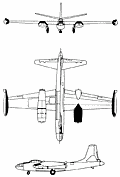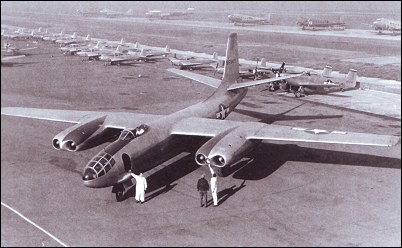 |
North American B-45 Tornado1947 |  |
| BOMBER, RECONNAISSANCE | Virtual Aircraft Museum / USA / North American |
 |
In 1943, aware of Nazi Germany's advances in the field of jet propulsion, the Army Air Forces (AAF) asked the General Electric Company to devise a more powerful engine than its prospective axial turboprop. This was a tall order, but it eventually brought about the production of the J35 and J47 turbojets. In 1944, 1 year after the jet engine requirements were established, the War Department requested the aircraft industry to submit proposals for various jet bombers, with gross weights ranging from 80,000 to more than 200,000 pounds. This was another challenge, and only 4 contractors answered the call. Pressed for time, the AAF in 1946 decided to skip the usual contractor competition, review the designs, and choose among the proposed aircraft that could be obtained first. The multi-jet engine B-45, larger and more conventional than its immediate competitor, won the round, with the understanding that if a less readily available bomber was to prove superior enough to supplant it (which the Boeing XB-47 did), that aircraft would also be purchased. Testing of the XB-45 prompted pre-production changes. North American Aviation, Incorporated, redesigned the nose panel, increased the aircraft's stabilizer area, and lengthened the tailplane by nearly 7 feet. In August 1948, 22 of the 90 B-45s, ordered less than 2 years before, reached the newly independent Air Force. However, the B-45's increased weight, excessive takeoff distance, and numerous structural and mechanical defects generated scant enthusiasm. Meanwhile, the B-47's future production had become certain, and in mid-1948 the Air Staff actually began to question the B-45's intrinsic value as well as its potential use. Soon afterwards, as President Truman's budgetary axe slashed Air Force expenditures, the programmed production of B-45s was reduced to a grand total of 142, a decrease of 51 aircraft. Although continuously plagued by engine problems, component malfunctions, lack of spare parts, and numerous minor flaws, the B-45 regained importance. Like all bombers produced after the end of World War II, the B-45 was designed to carry both conventional and atomic bombs. In mid-1950, when U.S. military commitments to the Korean War reempha-sized the vulnerability of the North Atlantic Treaty Organization forces in Europe to Soviet attack, the Air Force made an important decision. Since the U.S. planned to produce large quantities of small atomic and thermonuclear weapons in the near future, the use of such weapons, heretofore a prerogative of the strategic forces, would be expanded to the tactical forces, particularly in Europe. The program that ensued, under the code name of Backbreaker, entailed difficult aircraft modifications because several distinct atomic bomb types were involved and large amounts of new electronics support equipment had to be fitted in place of the standard components. In addition, the 40 B-45s allocated to the Backbreaker program also had to be equipped with a new defensive system and extra fuel tanks. Despite the magnitude of the modification project, plus recurring engine problems, atomic-capable B-45s began reaching the United Kingdom in May 1952, and deployment of the 40 aircraft was completed in mid-June, barely 30 days behind the Air Staff deadline. All told, and in spite of its many valuable secondary functions, the B-45 did not achieve great glory. The entire contingent, Backbreaker and reconnaissance models included, was phased out by 1959. Yet, the B-45 retained a place in aviation history as the Air Force's first jet bomber and as the first atomic carrier of the tactical forces. North American B-45 Tornado on YOUTUBE
|  COMPANY PROFILE | ||||||||||||||||||||||||||||||||||||||||||||||||||||||||||
 |

|


